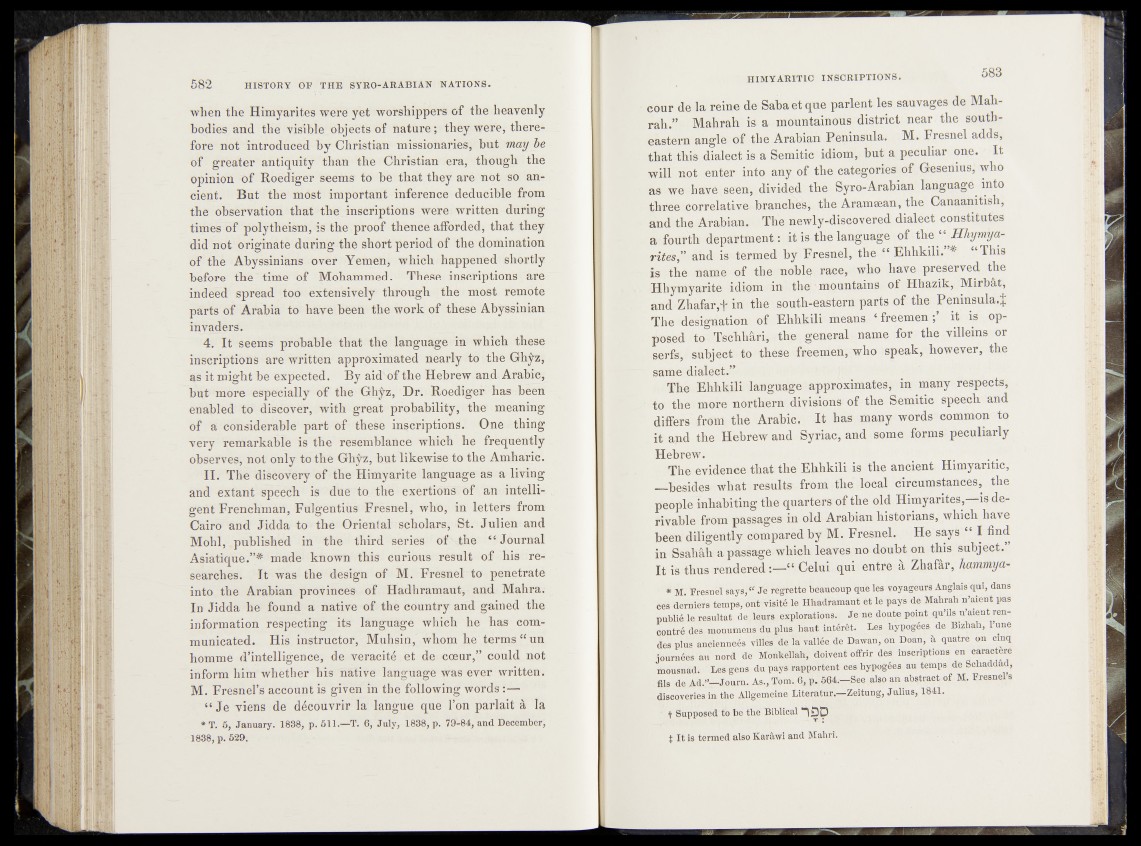
when the Himyarites were yet worshippers of the heavenly
bodies and the visible objeëts of nature ; they'were, therefore
not introduced by Christian missionaries, hut may be
of greater antti|pSty than the Christian era, though the
opinion of Iioediger seems to be that they are not so ancient.
But the most important inference deducible from
the observation that the inscriptions were written during
times of polytheism, is the proof thence afforded^ that they
did not originate during the short period of the domination
of the Abyssinians over Yemen, which happened shortly
before the time of Mohammed. These inscriptions are
indeed spread too extensively through the ! most remote
parts of Arabia to have been the work of these Abyssinian
invaders.
4. It seems probable that the language in which these
inscriptions are written approximated nearly to the Ghÿz,
as it might be expected. By aid'of the Hebrew and- Arabic;
but more especially of the Ghÿz, Dr. Boediger has -been
enabled to discover, with great probability, the- meaning
of a considerable part of these inscriptions. One thing
very remarkable is the resemblance which he frequently
observes, not only to the Ghÿz, but likewise to the Amharic.
II. The discovery of the Himyarite language as a living
and extant speech is due to the exertionsTxif an-intelligent
Frenchman, Fulgentius Fresnel, who, in letters from
Cairo and Jidda to the Oriental scholars, St. Julien and
Mohl, published in the third series of Nthe “ Journal
Asiatique.”* made known this curious result of his' researches.
It was the design of M. Fresnel to penetrate
into the Arabian provinces of HadhramauV and Mahra.
In Jidda he found a native of the country arid gained the
information respecting its language which he has communicated.
His instructor, Muhsin, whom he terms “ un
homme drintelligence, de véracité et de coeur,” could not
inform him whether his native language was ever written.
M. Fresnel’s account is given in the following words :—
“ Je viens de découvrir la langue que l’on parlait à la
* T. 5, January. 1838, p. 511.—T. 6, July, 1838, p. 79-84, and December,
1838, p. 529.
HIMYARITIC INSCRIPTIONS. 583
cour de là reine de Sabaetque parlent les sauvages de Mah-
rah.” Mahrah is a mountainous district near the southeastern
angle of the Arabian Feninsqla. M. Fresnel adds,
that-this dialëéÜIi's, à Semitic idiom, but a peculiar one. It
wl¬ enter into any of,the categories of Geseriius, who
as we - hRyei’s^rin/p divided th^Pyrof-Arabistn* language into
three eorrelativ^brane]^;, the Aramaean, the Canaanitish,
and the Arabian. The’^ewly^discovered dialect constitutes
a fourth department :.! it is-the language :ofthe “ Hhymÿar
rites” arid is-termed by Frefri^^ thê^“ Ehhkin|p|. “ This
is the name-of the m o b l ^ # ^ who have* preserved the
Hhymyarite 4djhm#nhthe 'mountains of Hhazik, Mirbât;
and Zhafar,t in r if^ south-eastern'pa^ts of the Feninsula.J
The designation of Ehhkili means 1 freemen it is opposed
to. Tschl%i^the general name for the villeins or
serfs,- subject to these^eemen, whp.fspeak, however, the
same dialect»*.-A
The Ehhkili language approximates, in many respects,
to the mole- northern divisions-of the speech , and
differs from the Arabic,: It has many words common to
_ it and the Hebrew and Syriac, and some forms peculiarly
Hebrew. . . .
The evidence that the Ehhkili is the ancient Himyaritic,
_besides what results-from -the local circumstances, the
people inhabiting the quarters of the .old Himyarlt^—is derivable
from passages in old Arabian historians, which have
been diligently-compared by M. Fresnel, He says “ I find
in S sa h â h a passage.which leaves:no doublon this subject.”
It is thus rendered :—“ Celui qui entre à .Zhafâr, hammya-
* M. Fresnel says,cf Je’’ regrette ëèàücbupqùe les voyageurs Anglais rpu, dans
ces 'dentiers tèxùps, oïttwisitê feHhadramant et le pays de Mahrah n’mëntpas
publié le résultat de f leurs, explorations. Je.me doute p^in.t,.gu!ils n’aient rencontré
des.xnonumens. dîu pins haut intérêt. Le^ bypogée^ de Bizhah, Fune
des plus ânëienneés viîles%ejk vallée de Dawan, onrï)oan, à quatre on cinq
jbùrnééé àU nord de M&kéllàhy dbitènt'’offrir d<# inscriptions eu- caractère
mousnad. Les-gens du pays.Apportent ces hypogées au temps de Schaddad,
fils de Ad.»—Journ. As., T o m ,6 * ^ 5 ^ S e e , a l s o an abstract of M. Fresnels
discoveries in the AUgemeine Litéràtur’:—Zeitung, Julius, 1841.
• t Supposed'to be the Biblical
t I t is termed also Karâwi and Mahri.